Video: Accurascale unveil new GWR tank engine models
Accurascale has unveiled its model of the GWR 57xx, 67xx and 8750 Class Pannier Tanks, describing it as “one of the most iconic tank locomotives of them all.”
The company has recently enjoyed success with its GWR 78xx Manor Class locomotives, and received positive feedback following the launch of its GER Buckjumpers. As a result, it decided to develoop a model that is both a GWR prototype and a tank engine.
The company has been researching and working on its pannier range for several years, including looking at all the variations over the history of the class.
Accuascale explains that “Like our class 37 project, amongst others, we have done our Panniers in “The Accurascale Way”, with lots of variations and detail differences. We have started by ‘filling the gaps' and cover variants never before offered in ready-to-run format. This means locomotives with backplate feed (not top feed fitted) feature heavily in our launch range. Another striking variation amongst the contractor built locomotives was the use of rivets for constructing the tanks. Later modifications like the large “8750” cab is also included as is the 67xx sub class that were built without steam heat or vacuum brakes – with relevant pipes and equipment missing from the model as per prototype.
“One smaller but no less important change is around the cab area. When built the 57xx class didn't have an external front handrail or bunker steps. The handrail was flush with the cab side and built into the beading, the steps were also a later addition which we have recreated on our model.
“It's not just big variations we have included. Smaller features like the whistles with or without a whistle guard, types of water filler which can either be screw down or clip down, position and number of spare lamp irons, cast or fabricated brake hangers, couplings were either screw link or 3 link and right down to the route of the injector overflow pipe, whether it ran through the running plate or around the outside, has been catered for. A vast suite of tools allows us the option to mix and match early and late features on the same locomotive, enabling a wide variety of prototypes to be recreated in faithful detail.”
In the launch video[1], pannier Project Manager Steve Purves takes an indepth look at the real thing.
[embedded content]
5754. Great Western livery
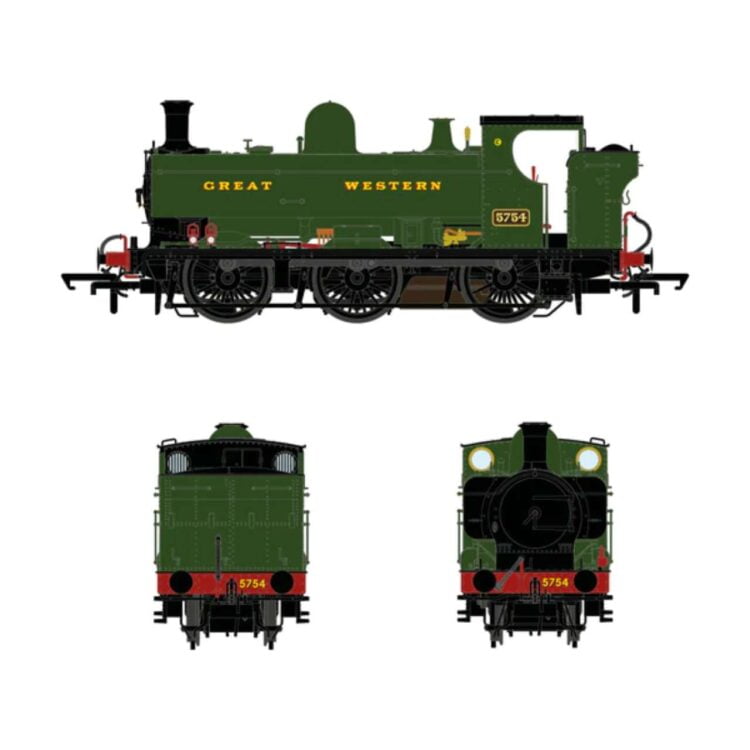 Credit: Accurascale
Credit: Accurascale
5754 was the fourth member of the 57xx class to be built at Swindon. The locomotive came out of the shop in 1929, and represents a standard pannier from this early period. It operated from Old Oak Common[2] shed and did not relocate until the war years. It spent just over thirty years in operational service, until in 1960 it was withdrawn from Stourbridge shed and scrapped.
Features: No top feed, early style cab handrails, no bunker steps, Injector overflow routed through running plate
6743. Great Western livery
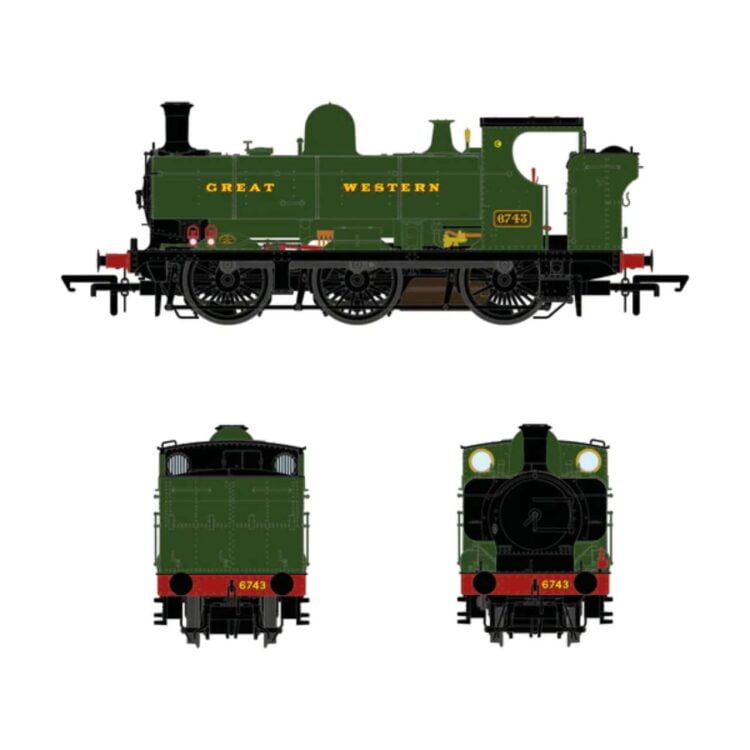 Credit: Accurascale
Credit: Accurascale
The 67xx was a subclass of panniers built without steam heat or vacuum brakes. The first twenty-five locos in the class were built by Bagnall's of Stafford[3]. However, this one is from the second batch of twenty-five, and was outshopped from the Yorkshire[4] Engine Company, Sheffield[5], in 1930. It was initially allocated to Ebbw Junction, and spent its whole working life in South Wales[6] before being withdrawn from Newport[7] Pill shed in 1959.
Features: No top feed, rivetted tanks, early cab style handrails, no bunker steps, Injector overflow routed through running plate
7755. GWR Shirt button Livery
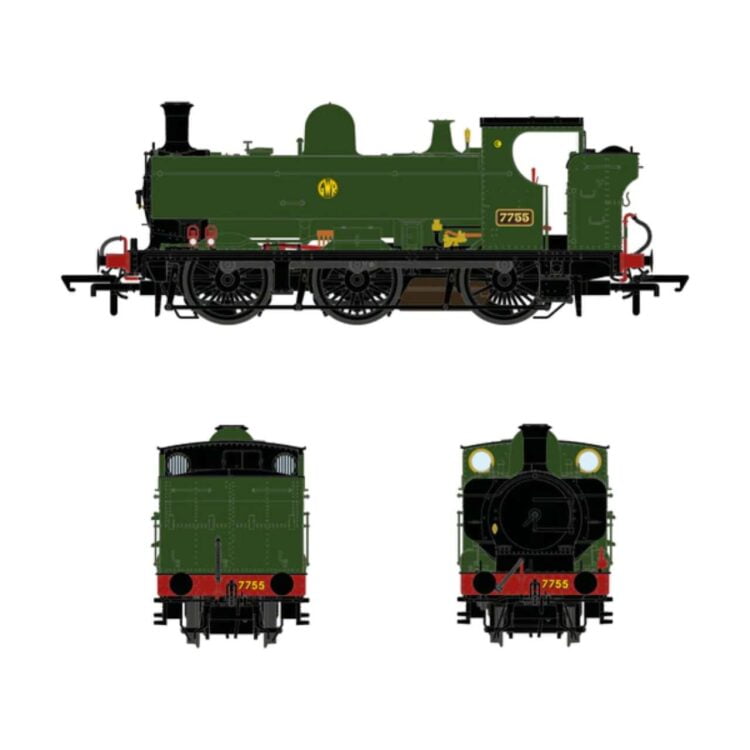 Credit: Accurascale
Credit: Accurascale
7755 was a locomotive from the ‘Work Creation' orders and was built in 1930 by North British Locomotive Co. at Queens Park works in Glasgow. It began working in Neath[8] shed, but by the late 1930s had gained the then new ‘shirt button' GWR logo and was transferred to Llanelly shed. It worked in South Wales for its whole life, and was withdrawn from Aberbeeg shed in 1962 and scrapped.
Features: No top feed, early cab style handrails, Bunker steps fitted, Injector overflow routed through running plate
5741. GWR Livery
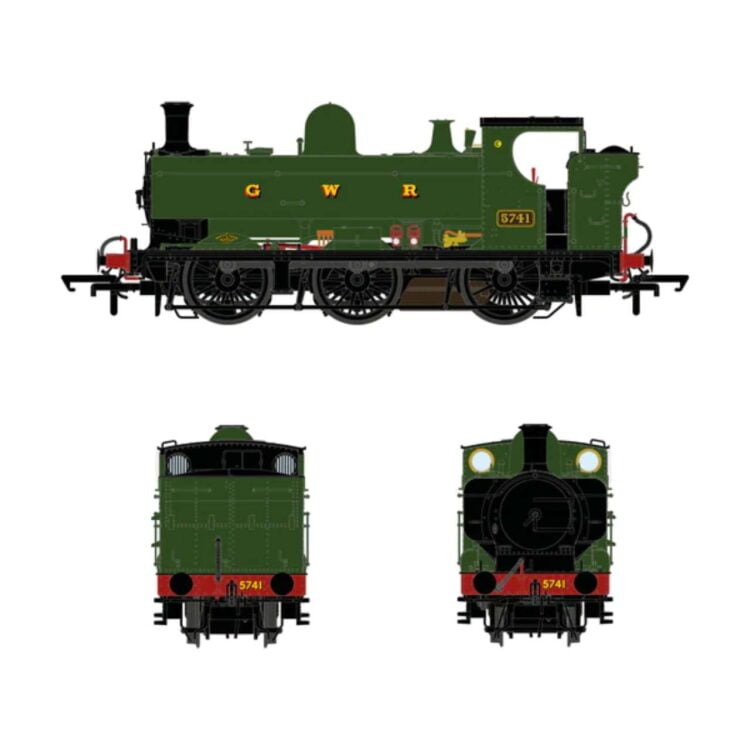 Credit: Accurascale
Credit: Accurascale
5741 was one of the initial order of fifty locomotives from the North British Locomotive Works, and emerged from Queens Park works, Glasgow in 1929. It was initially allocated to Aberbeeg but transferred to Ebbw Junction whilst in the condition represented here. It was withdrawn relatively early in 1957 from Newport Pill Shed. It is reputed that 5741 was the inspiration for (and number carried by) “Duck” in the Reveren. Awdry's Railway Series.
Features: No top feed, late cab style handrails, Bunker steps fitted, Injector overflow routed through running plate
9741. British Railways Green Livery
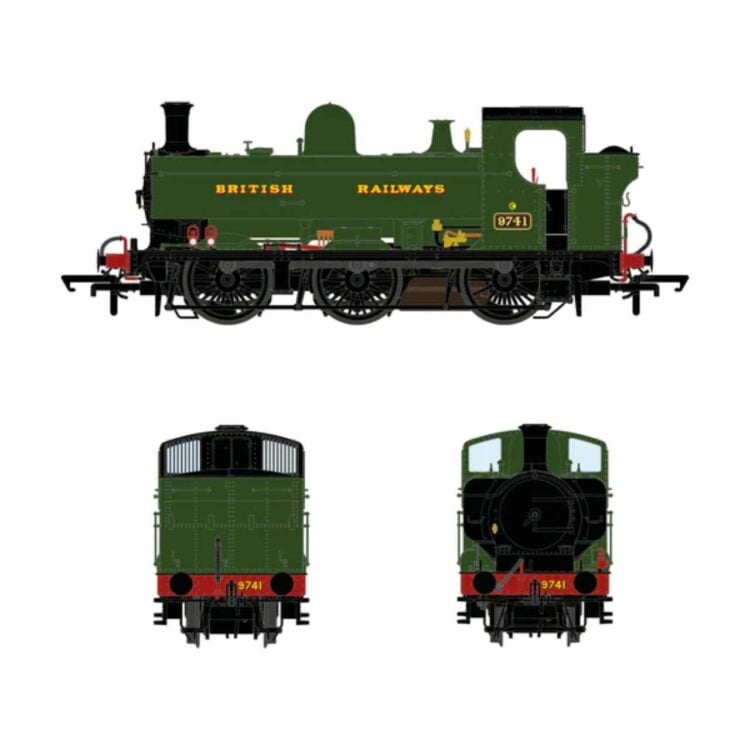 Credit: Accurascale
Credit: Accurascale
With the introduction of what became the ‘8750' variations, this 1935-built locomotive emerged from Swindon works with a new, enlarged cab but retaining some earlier-style parts such as water fillers and backplate feed. It was initially allocated to Stafford Road shed in Wolverhampton[9], and can be seen here as it was outshopped in the early British Railways livery lettered livery with GWR ‘Egyptian' typeface. In 1962, the loco was withdrawn from Wellington shed and scrapped.
Features: No top feed, 8750 style cab, Bunker steps fitted, Injector overflow routed through running plate.
8763. British Railways Lined black livery, with Early Emblem
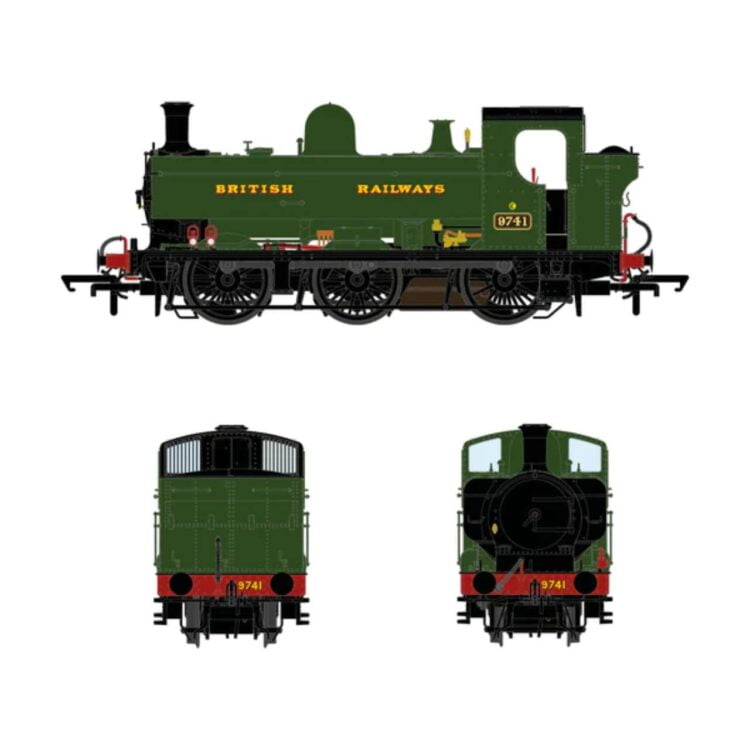 Credit: Accurascale
Credit: Accurascale
Built at Swindon in 1933, this locomotive was allocated to Old Oak Common and spent its working life there. By the early 1950s many panniers were fitted with top feed boilers. 8763 was treated to full mixed traffic lining because its duties included working empty coaching stock in and out of London[10] Paddington. It was withdrawn in 1962.
Features: Top feed boiler, 8750 style cab, Bunker steps fitted, Injector overflow routed outside running plate.
9681. British Railways Black Livery, Late Crest
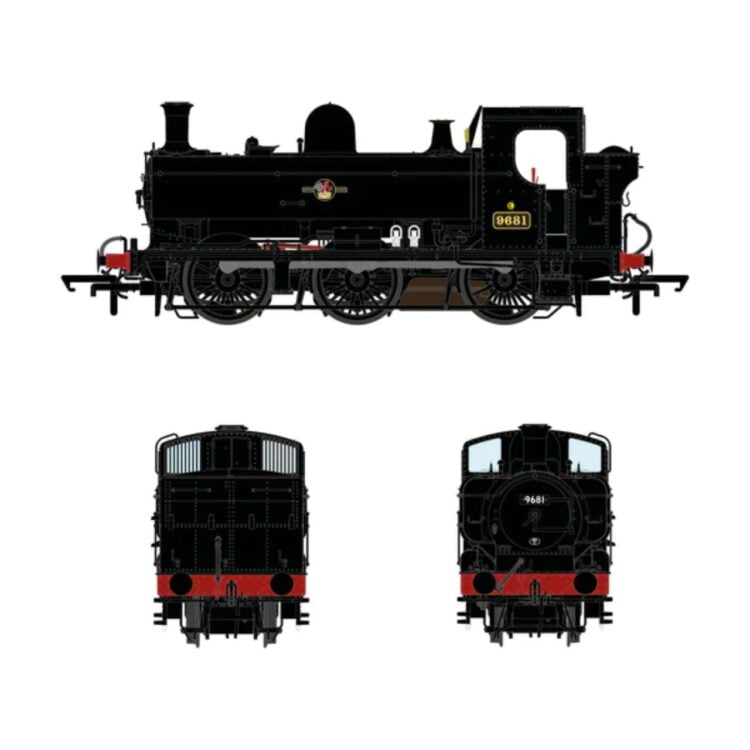 Credit: Accurascale
Credit: Accurascale
9681 was one of the last pannier tanks to be built. It emerged from Swindon Works in 1949 under the ownership of British Railways, and was one of the penultimate batch of ten locomotives. It was initially allocated to Tondu in South Wales, and spent periods at Oswestry[11] and Hereford[12] before being withdrawn from Cardiff[13] East Dock after a sixgeen-year working life. It was bought by scrap merchant Dai Woodham and a few years later was moved to the Dean Forest Railway[14] and returned to steam in 1984.
Features: Top feed boiler, 8750 style cab, Bunker steps fitted, Injector overflow routed outside running plate
7714. British Railways Black Livery, Early Emblem
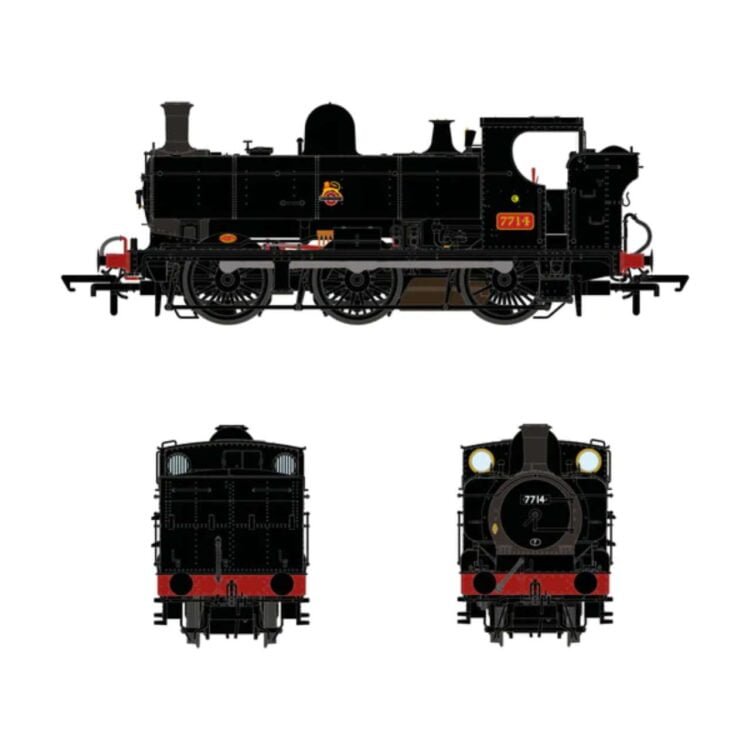 Credit: Accurascale
Credit: Accurascale
7714 was an early ‘contractor'-built locomotive, made by Kerr Stuart in Stoke-on-Trent in 1930. Initially allocated to Tyseley, it was soon sent North to Birkenhead. When it was withdrawn in 1959, the National Coal Board (NCB) bought it and sent it to work at Penallta Colliery in South Wales, where it worked here until it was bought by the Severn Valley Railway[15] in 1973. It was returned to steam and has been in service on and off ever since.
Features: No top feed, Rivetted tanks, Injector overflow routed through running plate
7754. NCB Green Livery
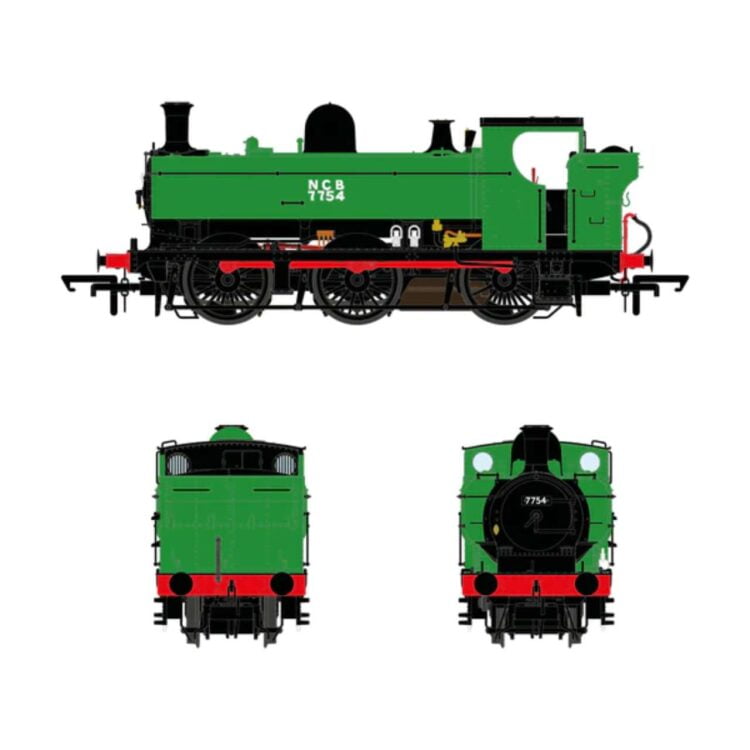 Credit: Accurascale
Credit: Accurascale
7754 was a product of the North British Locomotive Company. It was outshopped in 1930 and allocated to Reading[16] where it worked various trains. It spent time at Old Oak Common and Wellington, and was withdrawn from service in 1959. The NCB bought it for use in South Wales, first at Talywain Colliery and then at the new Mountain Ash[17] system where it worked until 1975. Rather than sell it to a private individual, the NCB donated it to the National Museum of Wales ,which placed it on permanent loan to the Llangollen Railway[18], where it returned to steam in 1994. It has just returned from a major overhaul.
Features: Top feed boiler, Bunker steps fitted, Injector overflow routed outside running plate, Toolbox and steam heat removed by NCB
Inside each model is a powerful, coreless motor geared to allow the pannier to perform like the real thing. Each has the usual twin LED firebox flicker arrangement and a pair of sugar cube speakers which reproduce authentic sound on DCC sound fitted models. The DCC decoder is accessed through a magnetically removable smokebox door and pull-out board for trouble free decoder.
The locomotive is now fully tooled, and the first samples will be on display on the company's stand at the 2023 Warley Model Railway Club Exhibition at the NEC in Birmingham[19] this weekend. The samples are being tested and evaluated before being decorated and produced.
Accurascale expects the model locomotives to be in stock in the first quarter of 2025. The Pannier Tanks are priced at:
- £139.95 for DC/DCC Ready models
- £239.95 for DCC Sound Fitted models.
Enthusiasts may pre-order online[20] and arrange to pay via monthly instalments at no extra cost, or via local stockists.
In the coming months, Accurascale will make a further announcement of a model available exclusively via the Accurascale website only.
Accurascale has thanked the Dean Forest Railway, The Great Central Railway[21] and The Severn Valley Railway for their help and assistance in producing this model.
Detailed Specification
- Highly detailed 0-6-0PT 00 gauge model, 1:76.2 scale on 16.5mm track
- Minimum Radius 438mm (2nd radius set track)
- RP25-110 profile 00 gauge wheels
- Coreless motor with flywheel geared for maximum performance and slow speed running
- Die-cast metal chassis and pickups to all wheels.
- Next18 DCC ready or ESU LokSound V5 sound fitted, slot mounted in smokebox
- PowerPack capacitor for uninterrupted power
- Two quality sugar cube speakers contained in sound capsule located for best possible sound.
- Small, flexible neck NEM coupler mounts set at correct height, with mini-tension-lock couplers.
- Brake rigging factory fitted
- Brake blocks aligned with wheels
- Scale width wire handrails and sand pipes
- Fully detailed cab interior with twin LED pulsing/steady Firebox glow
- Etched metal/plastic detail parts, including grab handles, steps, buffer pipework, lamp irons etc.
- Turned brass whistles etched whistle shields (where fitted)
- Sliding roof ventilator
- Etched metal pre-painted number plates and works plates.
- Fully sprung metal buffers, factory-installed pipework and screw/3 link couplings
- Magnetically removable smoke box door.
References
- ^ Posts tagged with Video (www.railadvent.co.uk)
- ^ Posts tagged with Old Oak Common (www.railadvent.co.uk)
- ^ Posts tagged with Stafford (www.railadvent.co.uk)
- ^ Posts tagged with Yorkshire (www.railadvent.co.uk)
- ^ Posts tagged with Sheffield (www.railadvent.co.uk)
- ^ Posts tagged with Wales (www.railadvent.co.uk)
- ^ Posts tagged with Newport (www.railadvent.co.uk)
- ^ Posts tagged with Neath (www.railadvent.co.uk)
- ^ Posts tagged with Wolverhampton (www.railadvent.co.uk)
- ^ Posts tagged with London (www.railadvent.co.uk)
- ^ Posts tagged with Oswestry (www.railadvent.co.uk)
- ^ Posts tagged with Hereford (www.railadvent.co.uk)
- ^ Posts tagged with Cardiff (www.railadvent.co.uk)
- ^ Posts tagged with Dean Forest Railway (www.railadvent.co.uk)
- ^ Posts tagged with Severn Valley Railway (www.railadvent.co.uk)
- ^ Posts tagged with Reading (www.railadvent.co.uk)
- ^ Posts tagged with Mountain Ash (www.railadvent.co.uk)
- ^ Posts tagged with Llangollen Railway (www.railadvent.co.uk)
- ^ Posts tagged with Birmingham (www.railadvent.co.uk)
- ^ pre-order online (www.accurascale.com)
- ^ Posts tagged with Great Central Railway (www.railadvent.co.uk)